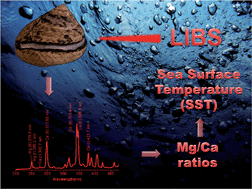Mg/Ca ratios measured by laser induced breakdown spectroscopy (LIBS): a new approach to decipher environmental conditions
Abstract
The potential application of Mg/Ca ratios in top shells of the mollusc species Phorcus lineatus (Da Costa, 1778) obtained by Laser Induced Breakdown Spectroscopy (LIBS) has been evaluated as an environmental proxy to reconstruct paleotemperatures and season of capture of molluscs for the first time. All samples were collected from the Cantabrian Sea (Spain). The results were compared with instrumental sea surface temperatures (SSTs) and with a known reliable proxy as the oxygen isotope ratio (δ18Oshell) which is mainly dependent on the SST, obtained from the same shells. Measurements were taken in two different biominerals of the shell (aragonite and calcite) resulting in a correlation between Mg/Ca ratios and SSTs of R2 = 0.43 and 0.44, respectively. Mg/Ca ratios were also studied through a long sequence on three shells collected in autumn 2012. The results show variations in Mg/Ca ratios related to seasonal changes in the SST throughout the year and a good correlation between Mg/Ca ratios and δ18Oshell in two shells (R2 = 0.70 and 0.65, respectively).


 Please wait while we load your content...
Please wait while we load your content...